From growing up in the bold colors of the ’80s to creating quilts that tell deeply personal stories, Mindy Brown has always embraced art as a way to explore, play, and push boundaries.
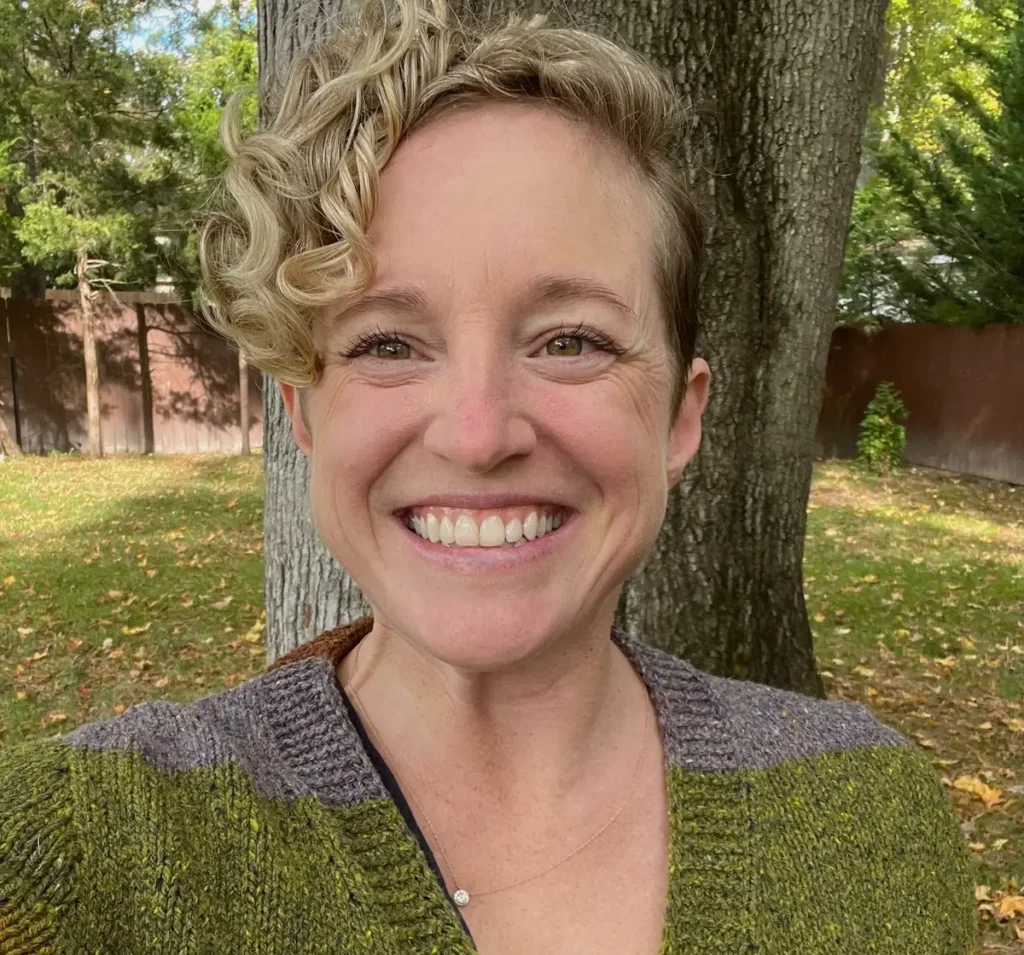
What’s your first memory of playing with color and fabric?
My mom made a lot of my clothes when I was a kid, and it was the 80s!
All the fabrics she picked were bright, wild patterns that she would sew into matching tank tops and shorts for me and my sister. I loved all those outfits, and they, along with the colors of the 80s, made a huge impression on me.
Beyond sewing clothes for us, my mom encouraged any form of art, and I also did a lot of drawing, painting, collage, and pottery. I don’t ever remember her saying “no” to craft supplies.
As an Amazon Associate I earn from qualifying purchases. Read more about our affiliate linking policy.
Who taught you to sew? What’s one lesson you still hear in your head?
My mom taught me to sew when I was very young. I started with printed panels that made stuffed animals and simple quilts and moved on to garments. I don’t really remember any rules or specific lessons that resonate with me but it was definitely the foundation of all my creative pursuits today.
My mom also never hesitated to make something. She once made my sister a Killer Tomato costume using a tennis ball costume as the base. I really learned from her to figure things out on my own.
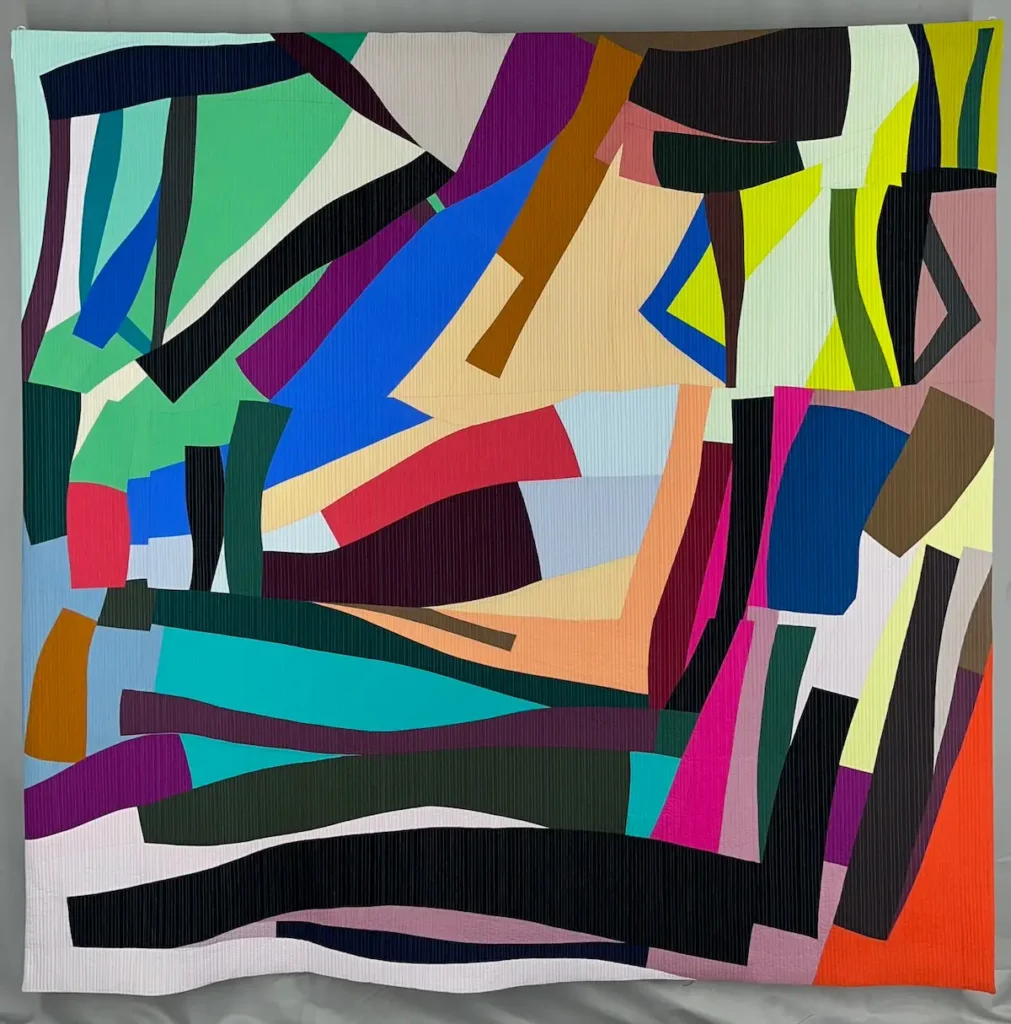
Where do you find inspiration for your designs?
I don’t think I have moments of inspiration or see something and think “I need to make this into a quilt,” instead, everything kind of seeps in.
Shapes that I see or color combinations in nature will later affect a design, but I often don’t realize it at the time. Once you make a practice of creativity, your mind is more open to it, and you collect inspiration from everything.
I doodle a lot to think of shapes and figures I want to use in quilts but the real inspiration is on the design wall. I like to think about how large I want to make a quilt and then fill in that space with shapes.
I’ve also started working through the design process with paper collage. I took a class with David Hornung in 2024 and learned so much about the elements of design. In fact, the last couple of quilts I’ve made are from collage “first drafts.” It is really quick to cut out paper and glue it compared to cutting fabric and putting it on the design wall – and cheaper! In the time I could mock-up a quilt, I could make 50 paper collages. It is really a useful tool and something that I enjoy working on.
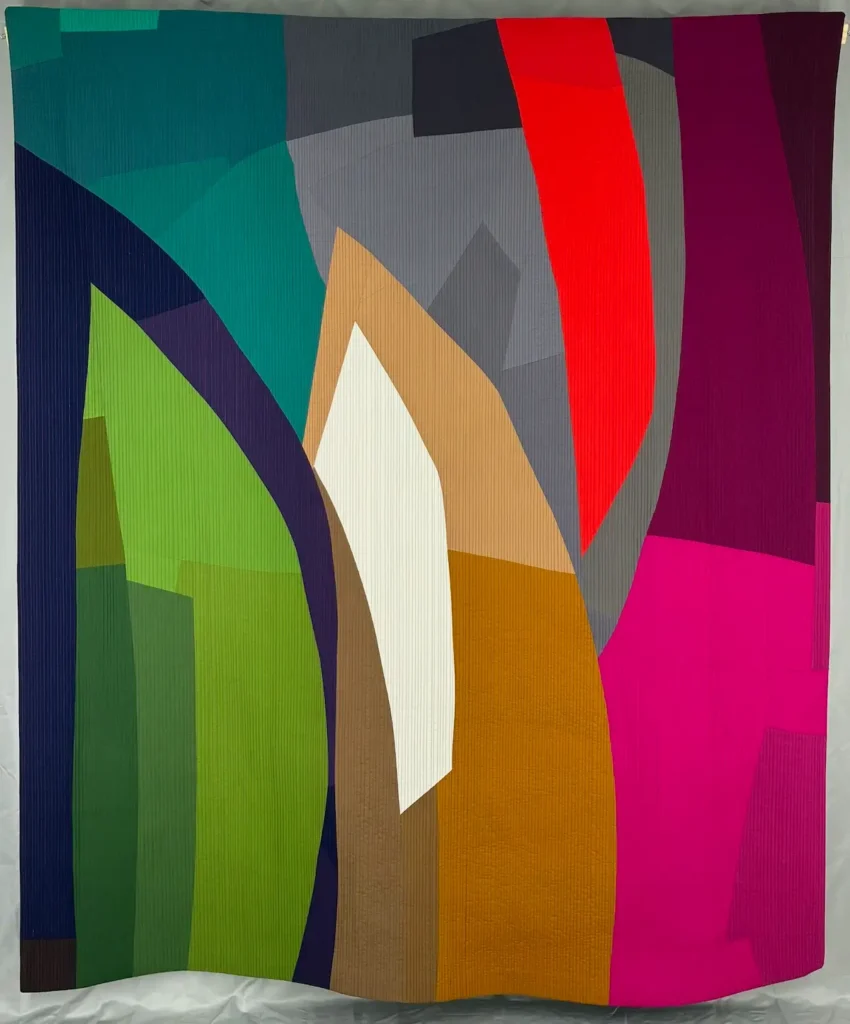
You moved a lot as a child. How has that shaped your eye for pattern and design?
I’m sure subconsciously that living in different parts of the US has an impact on my design and color choices, but the bigger impact was being uncomfortable and trying new things.
When you have to make new friends and start in a new school every 2-3 years, you learn that being uncomfortable is OK. You learn to sit with yourself and say I can do this. I think this has made a greater impact on my art because I never think to myself “I can’t do that.”
If there is a design I want to tackle or a technique I need to use, I just figure it out and go for it. I may not get it right the first time, but eventually I do, and that has allowed me to create the art that I truly want to share with the world.
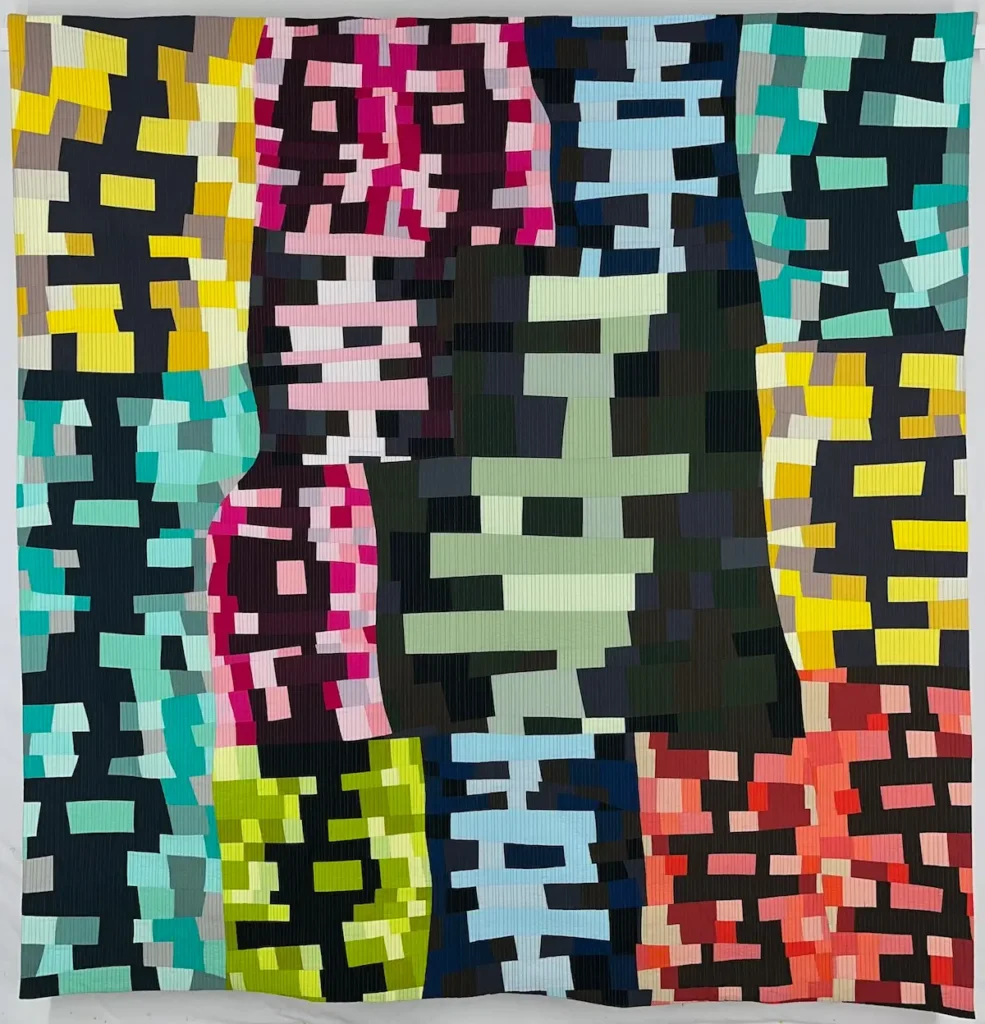
When did sewing switch from “a thing I can do” to “this is my thing”?
Art has always been my thing and I come and go from different avenues of creating as they fit my life.
During graduate school, I made t-shirt quilts for customers to have some extra money, and when I was in law school, I did a lot of knitting because it was portable and easy to pick up and put down.
Once I started my career, I had more time and resources to pursue quilting again. It has always been my first creative love, and I’m so happy I’ve transitioned to this new phase where I design my quilts and make things from my soul.

Describe your creative space.
Organized chaos.
I’m fortunate to have quite a lot of dedicated studio space and enough room for a long-arm, but it is still jam-packed with supplies, knick-knacks, books, two dogs, and a sloth balloon I got for my 40th birthday. I mostly know where everything is, much to my husband’s dismay.
The space gets extra messy while I’m working on a design, and when it is done, I clean up and start over. I love my very loud, cozy space and wouldn’t change it for an organized and tidy space for anything.
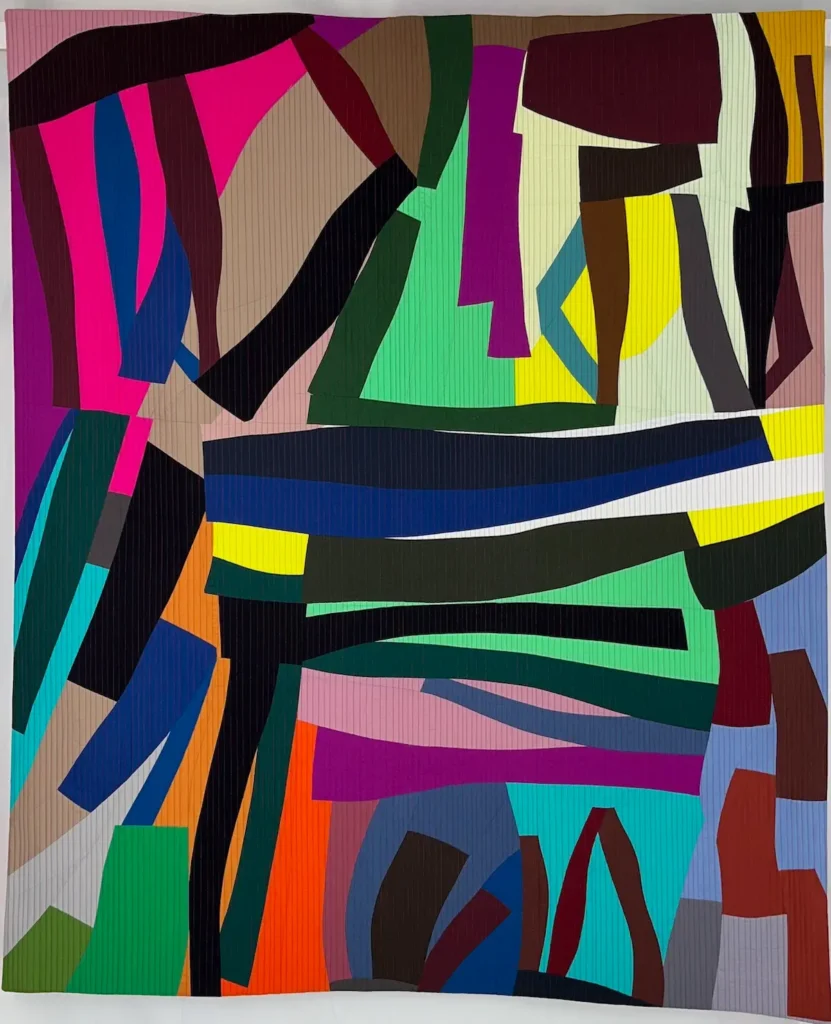
Your compositions use hundreds of small pieces. How do you keep your flow without getting lost in the tiny parts? (And, losing some of the tiny parts!)
Oh the tiny parts are the flow!!
Sewing them together and figuring out where they go is the best part. I also do some strip piecing, so that cuts down a little on tiny parts, but I really love the construction. Thinking ahead three steps to make sure the next seam is indeed next, it’s the best part. It hurts my brain in such a good way!


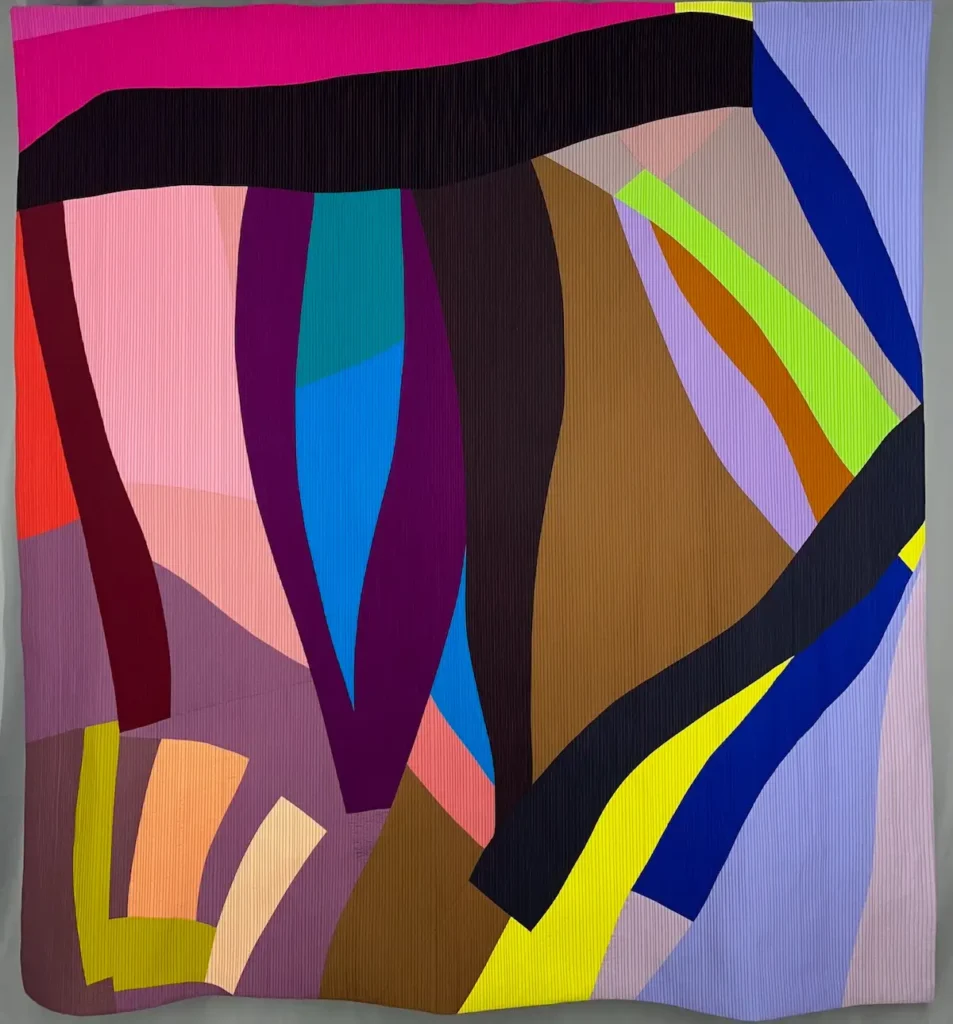
How do you know when a quilt is finished?
That is tough. There is always something that I think can be better in my quilts. I am also very critical of my own work. I look at my quilts juried into exhibits and think “oh, I could have done that different, or changed that color.”
One aspect that I really think about now is if the figure and ground shapes are pleasing. If I like them, then the rest of the design will work. Once I fill in all the fabrics on the design wall, I take photos and look at those photos a lot before sewing it all together. The photos help me see the quilt differently, and I often find something that I want to change. Sometimes, though, you just have to say “enough” and sew it up.
What part of quilt design do you enjoy the most? Which part gives you the most challenges?
I love cutting fabric. LOVE it! Cutting out new shapes and making those first design choices is really exhilarating. It can also be the most challenging. I’ll have an idea in my head of what a shape or figure should look like and sometimes you have to cut a couple of times to get it right. But when the line and weight and curve are just right, it is such a dopamine hit.
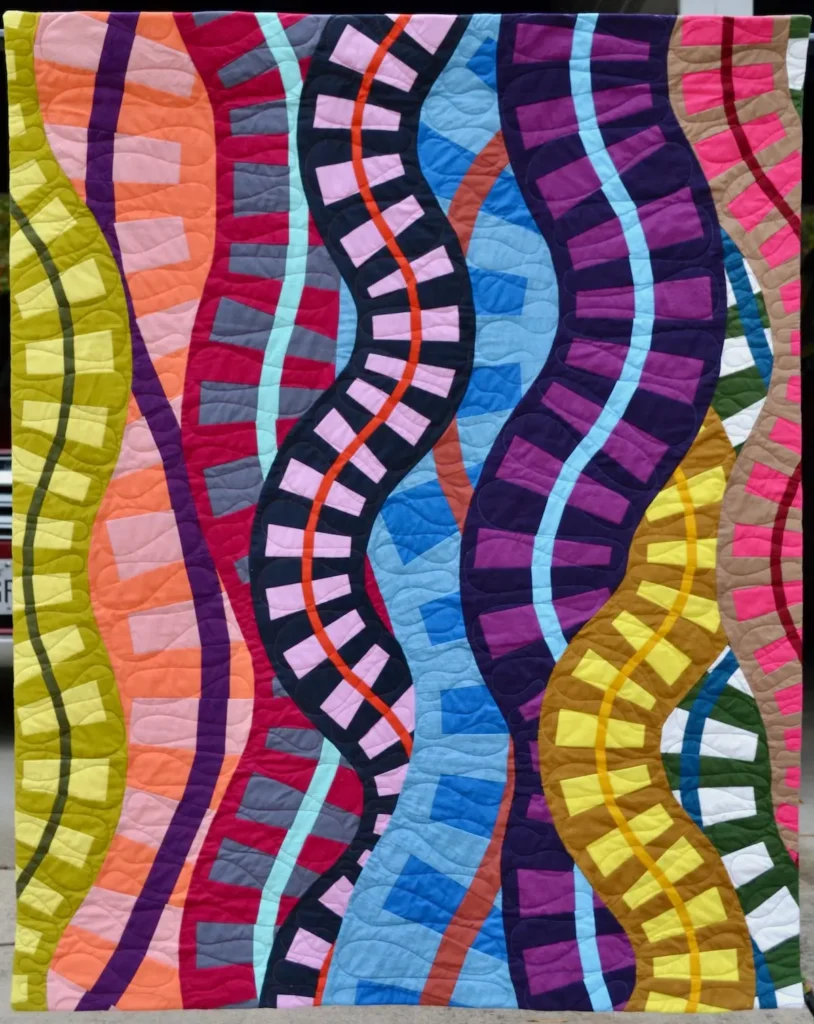
Your Vertebrae series is personal, about spinal challenges and coping. How did you choose abstraction to share that story?
I don’t think that was my original intention. When I start making a quilt, I don’t always know why I’m making it. It is something that I need to express and it comes out in the beginning stages of the design process. I usually don’t think about why I’ve made a quilt until it is done and I think about what I want to name it.
The Vertebrae series has not only been about my back but also my development as an artist. These quilts have taken me from one of my first quilts that I designed, through learning about figure-ground composition, value, different piecing techniques, and probably many other things I’m unaware of. But truly, after I made the first one, I thought, “I’m trying to understand what is going on with my back.” And then they were cathartic.
I made Vertebrae #8 right before my neck fusion surgery, and the hot pink, in reflection, is my pain.
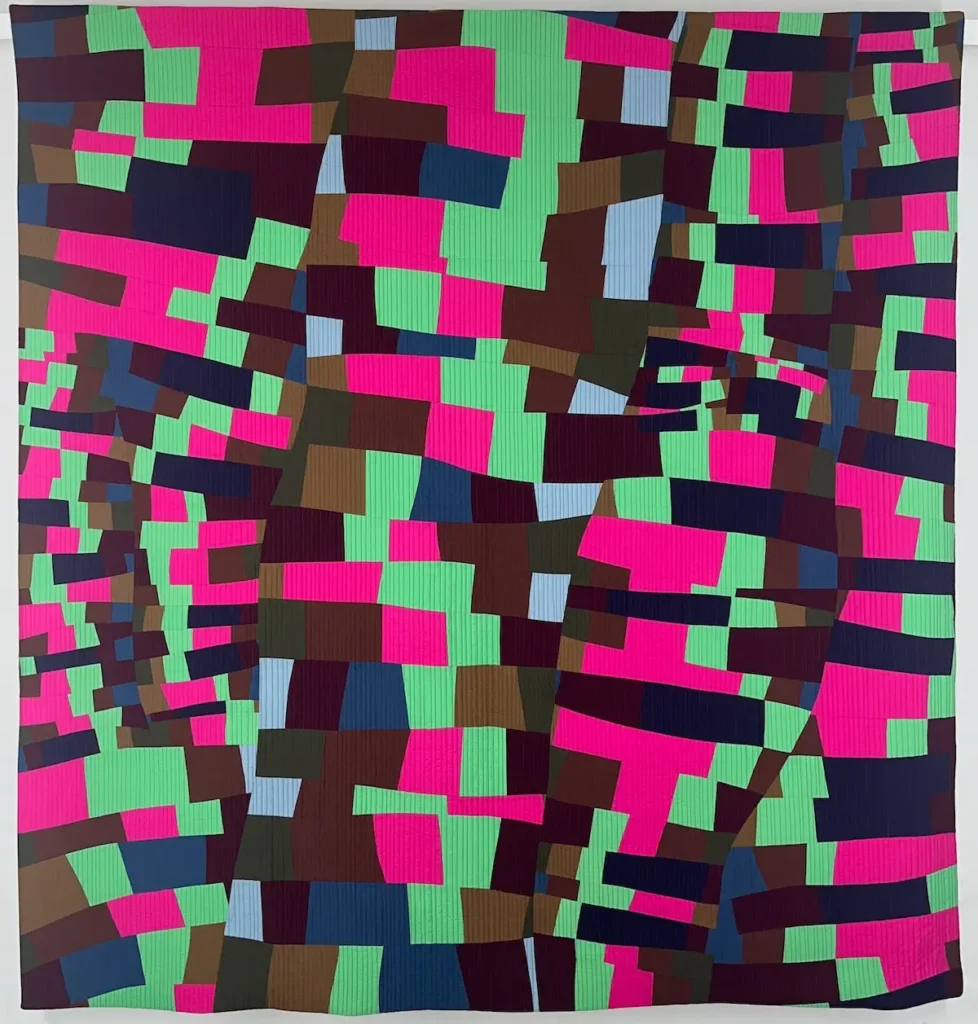
What’s one piece of advice you’d give a beginner quilter?
I know this probably sounds cheesy, but just try. There is no wrong or right way to quilt. Sure there are some techniques to learn but there is no right or wrong way to make art. It doesn’t matter how you do it, you should just try. If you can’t figure it out, ask for help.
I’ve taken (and still take) numerous classes and have worked with a mentor for the last 3 years. You can always learn something more, but you have to try. If you have fabric, scissors, a needle, and thread, you can make a quilt.
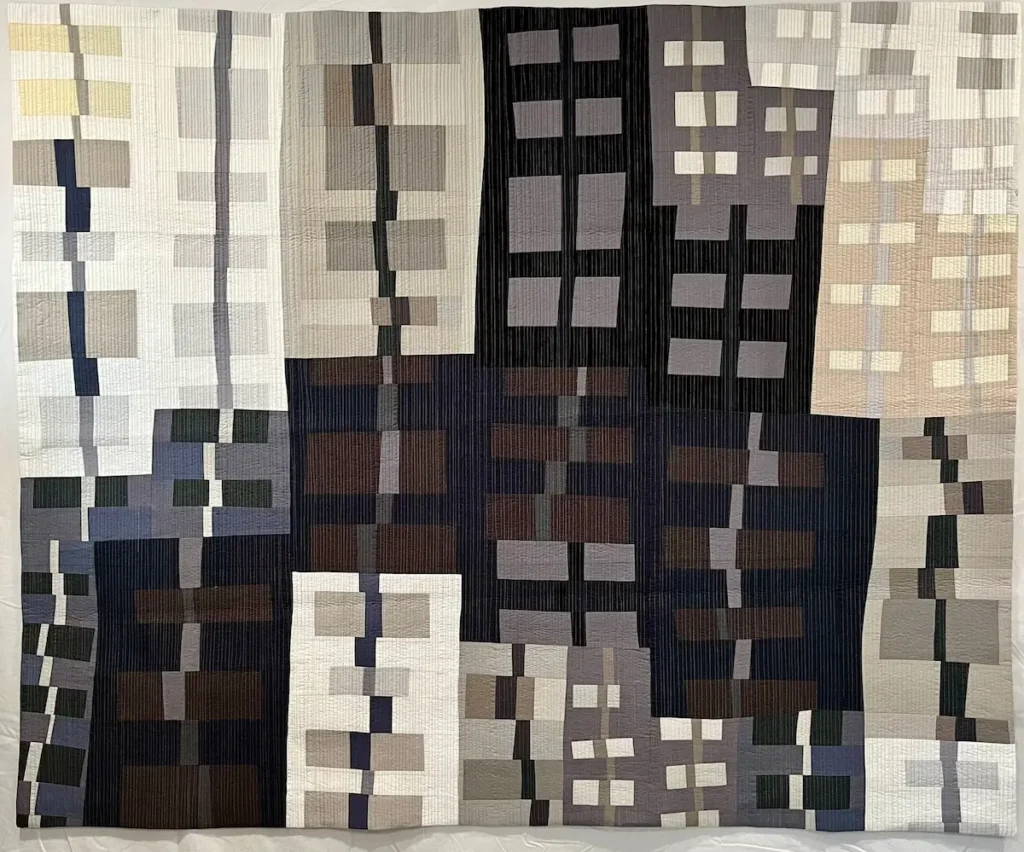
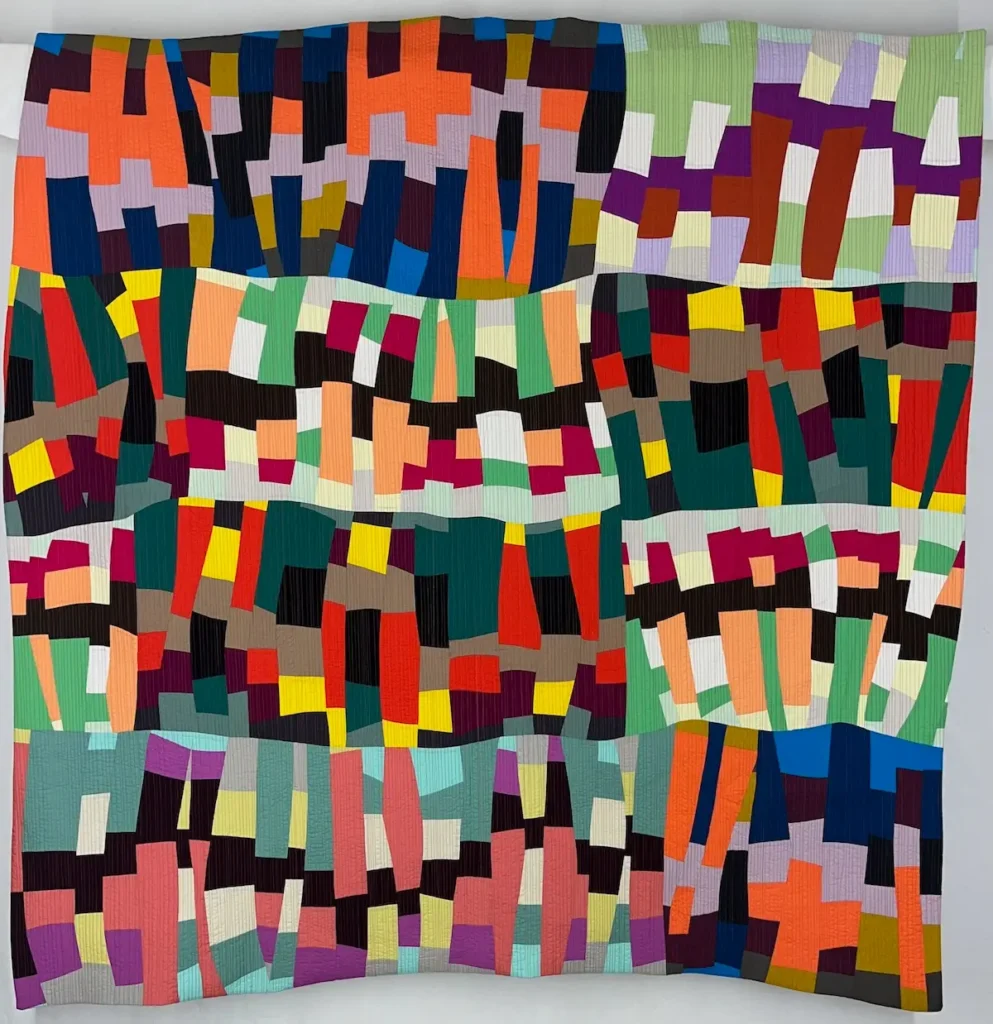

Do you have a secret for keeping ideas fresh and innovative?
Do what is in your soul. I work with colors and shapes, and fabrics that help me express myself.
I have a great deal of curiosity. After I finish a quilt design, I’m usually thinking, “What can I do with this next?” Each quilt usually spawns at least three more.
I’ll take an aspect of a quilt and turn it into another quilt or change the arrangement or the scale. There are so many possibilities, that I think if people just play a little bit, they will see all the things they can create.
Trying to think of the whole quilt design up front is daunting! Even if I make a quilt from a paper collage, I always change something as I go. The best thing about improv quilting is to just make it up as you go. You have more ideas in your head than you think; you just have to start.

How do you balance your professional life and make time to create?
One of the reasons I went into public service is the work-life balance that it affords. Not only do I serve the people of the US, I get to take time off and (usually) only work a 40-hour work week. This allows me time each day to work in my studio and I’m always amazed at how much you can accomplish with small increments of time.
Even just 30 minutes a day can result in a lot of progress. I also work from home and don’t have kids, so my time is very much my own.
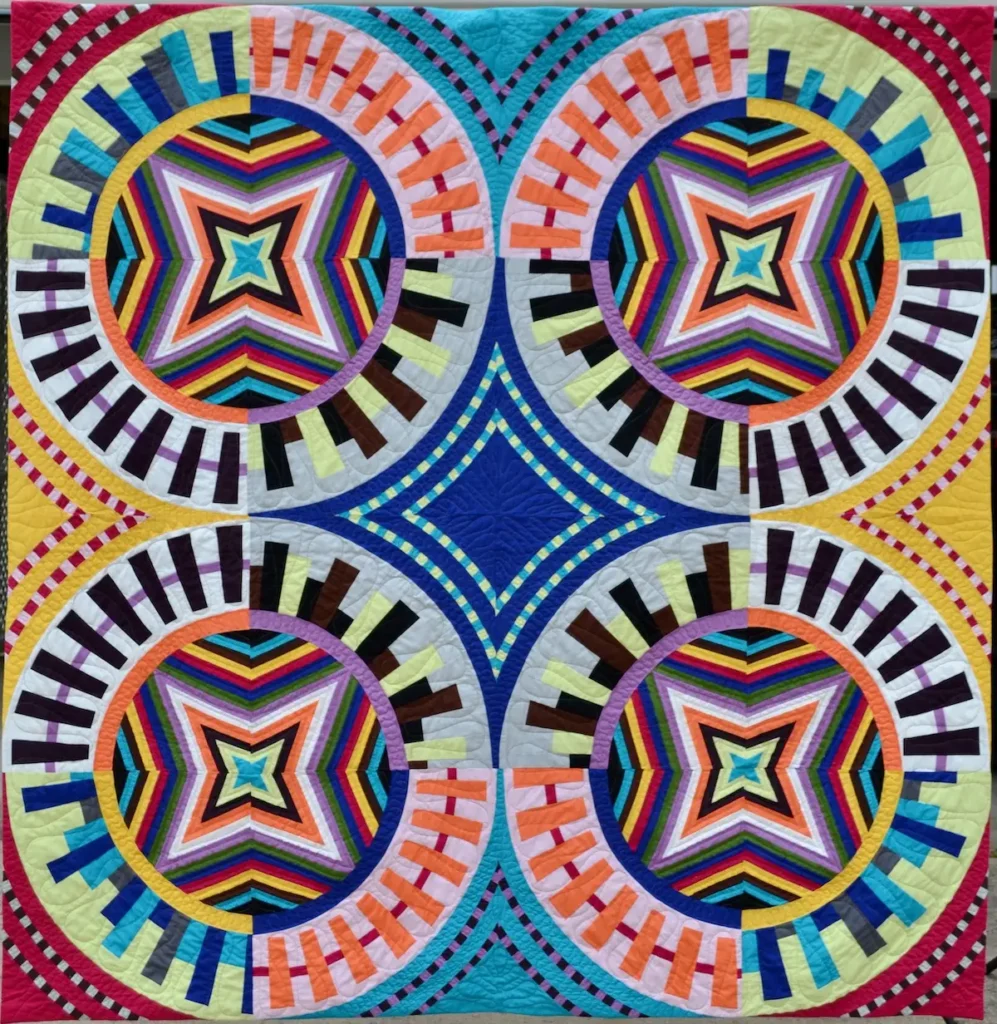
When you have the time to create, how do you flip the switch from attorney-brain to artist-brain?
I actually think they are one in the same. Most of what I do as an attorney is problem solving. It is more creative than you would think! I think the puzzling out of something in the law directly translates to sorting out how to put different elements together in a design and then how do I sew it all together.
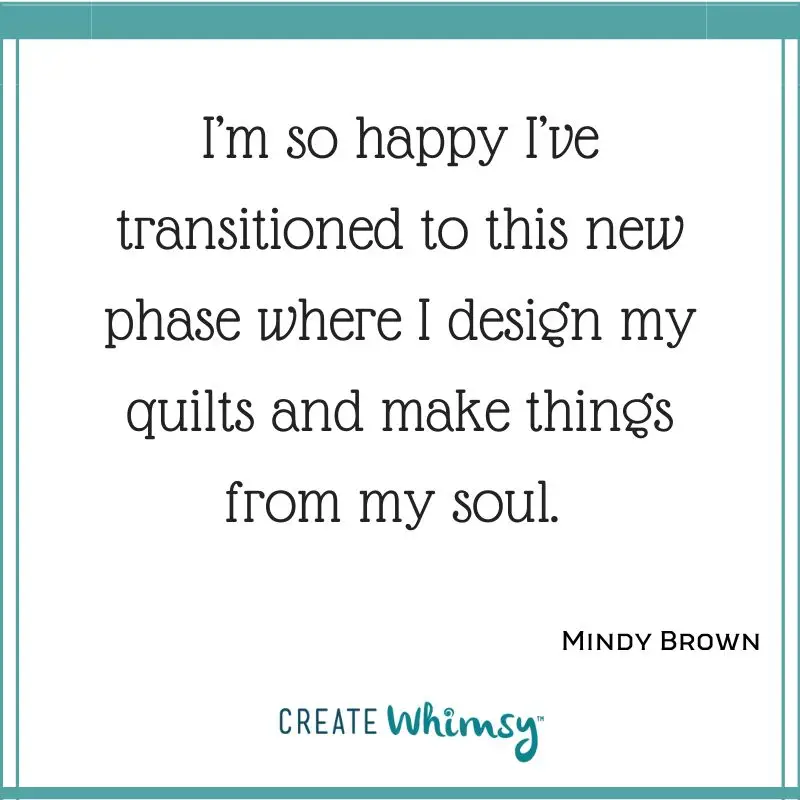
What’s a question you wish people asked about contemporary quilts, but rarely do?
I wish people viewed contemporary quilts as art. I know that isn’t really what you have asked here, but quilts are art, and they are fine art.
I am trying to make the art world see that. I enter my quilts into exhibits and shows that are not quilt-centric. I think that awareness and showing quilts alongside paintings, photography, sculpture, and collage is really important for the quilting community as a whole.
To further that purpose, I am part of a new art gallery: Textile Art Gallery NYC. Located in the heart of Chelsea, New York City’s premier arts district, this gallery will feature work primarily from quilters in monthly shows with an all-member show once a year. It is located in a building with other art galleries, and it will be exciting to see what happens!
Where can people see your work?
My website: mindygbrown.com
Instagram: @a_study_of_mindy
Interview posted September 2025
Browse through more contemporary quilts and inspiration on Create Whimsy.

